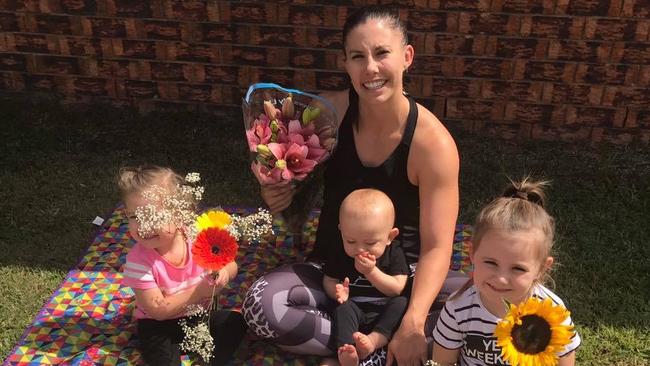
We say that every time.
We say it when men drown their children; when they throw them from bridges; when they choke and shoot and beat them. We say it every week or 10 days in Australia, because that is how often a man raises a hand, a gun, a knife, and kills a woman.
We also endure, after every such incident, those who say: oh well, maybe they were driven to it.
Probably this does not need restating but a woman cannot drive a man to murder her.
She cannot make a man murder his own children.
If someone is “driven to” something then, logically, somebody “drove them” to it, which would make the driver to blame, in which case, this latest catastrophe, the death of a woman and three children in a flaming car in Brisbane, is not the fault of the man who lit up the petrol. It’s her fault.
Except when you say it like that you realise: a mother cannot be blamed for her husband’s decision to leap into her car and splash the children with petrol and set them on fire and watch them burn.
She cannot be blamed for his decision to try to intimidate those who tried to get the children out of the car. She cannot be blamed for the skin that peeled off her body after he set her alight.
The murder of Hannah Clarke and her children was a baroque and macabre act of violence. Pure evil. It’s obscene to suggest otherwise. There are some who do not want this debate to be one about gender, but it is. And here we enter tricky territory.
There was a filicide conference in Melbourne last year. Filicide: the killing of one’s children.
The data presented suggested women kill their children as often as men do. It is the one crime that knows no gender.
What happened in Brisbane is more accurately familicide; the perpetrator kills his wife, children, other family members, and often himself. It’s a rare crime in Australia, and it is, I think we can say, exclusively men that do it.
Why we argue about the statistics is anyone’s guess. It’s a simple fact that male violence against women is a national crisis. When a woman is murdered, it’s almost always a man that does the killing and these partner homicides happen slightly more than once a fortnight.
How do we stop it happening?
We know violent men are not always easily identified. Some have previously been violent. Some are abusive in ways that are harder than a punch to detect: they are controlling about the household finances, or they shame and belittle their partner behind closed doors.
Hannah Clarke’s husband was awful to her for a long time, but not in a way that would attract a criminal penalty. A decade into the relationship, she found the courage to leave. He did not think that was her decision to make. He sought ways to bring her to heel — begging, crying, coaxing, threatening — and then, when she bravely kept on her way, his despair curdled into anger that begets rage that begets violence.
He had been identified as a risk to her. We have a system for dealing with risk. It involves the woman, or police, taking out an AVO, a “restraining order”.
Hannah had an AVO, but it’s a piece of paper at the end of the day, and her estranged husband probably took umbrage. You want me to stay away from my wife? She’s my wife.
Her family, since Hannah’s death, has cited plenty of warning signs as to his controlling nature. Sandra Taylor, a cousin on his mother’s side, has said: “For everybody else, they’re shocked; I’m not.”
Isaiah, his son from an earlier relationship, said: “His appalling parenting caused irreversible damage to my mental health … If I could take the place of (the dead children) I would in a heartbeat … We shared a similar bond, as we both suffered years of abuse and torment at (his) hands.”
It’s obvious now more needed to be done to protect Hannah and her children, but what?
One plan involves targeting all men who are separating from their families for intervention and monitoring. With the greatest respect, it’s not the answer.
There are more than 45,000 divorces in Australia every year and while it’s almost always an exquisitely painful experience, the vast majority of separations do not involve violence. Probably there are many women upset by the idea their former husbands ever posed a risk to them.
Relationships break down, it hurts, and then you move on. Not always so simply. There will be rage, and tears. But moving on is the story for most people.
It may be possible to target some men for intervention. Hannah’s estranged husband would, had we the luxury of having our time over, be an obvious candidate.
The Family Court has a system for referring agitated men to courses designed to encourage them to see how frightening their behaviour has become, for their former wife, kids, new girlfriend, mothers and sisters.
Some men won’t avail themselves of the services on offer. They will use the family law system to take back control of “their wives” and “their kids”.
We know the most dangerous time is when a woman is leaving, or soon after she’s left. There have been cases where men have been encouraged to see doctors to deal with depression after a marriage breakdown. They are referred to mental health professionals, and have still gone on to kill.
This is a complex problem.
We’re relying on a range of services to detect the moment just before a man snaps. We do a good job in this country of reminding people: if you feel suicidal, you should call this number. What we need, it seems, is an entirely new service: when you feel homicidal, you must call this number.
Hannah’s estranged husband was a man whose thinking about women, and his own identity as a man, was bent utterly out of shape. He’d been that way a long time. We know from similar cases such men grow up with absent fathers; or raised in abusive homes, where they, their siblings, and their mothers were cowed. It feels right to them, to have wives and kids who are jumpy.
A young woman may fall in love with an abuser — these men are often narcissists, and can be so charming — but time goes by, and the scales fall from her eyes. She will often sense the danger.
It must have taken so much courage for Hannah to leave her marriage, and can’t you not see her, just months into her hard-won independence, kids in the car, heart full of hope and head full of dreams … And then he grabbed the door.
Could their deaths have been prevented? We don’t know. What we can say for certain is that until her last breath, Hannah was trying to protect her children. Can we say the same? It’s a question we must urgently answer, for the next innocents. They are due to die this week.




We have to stop men from killing their wives and children.